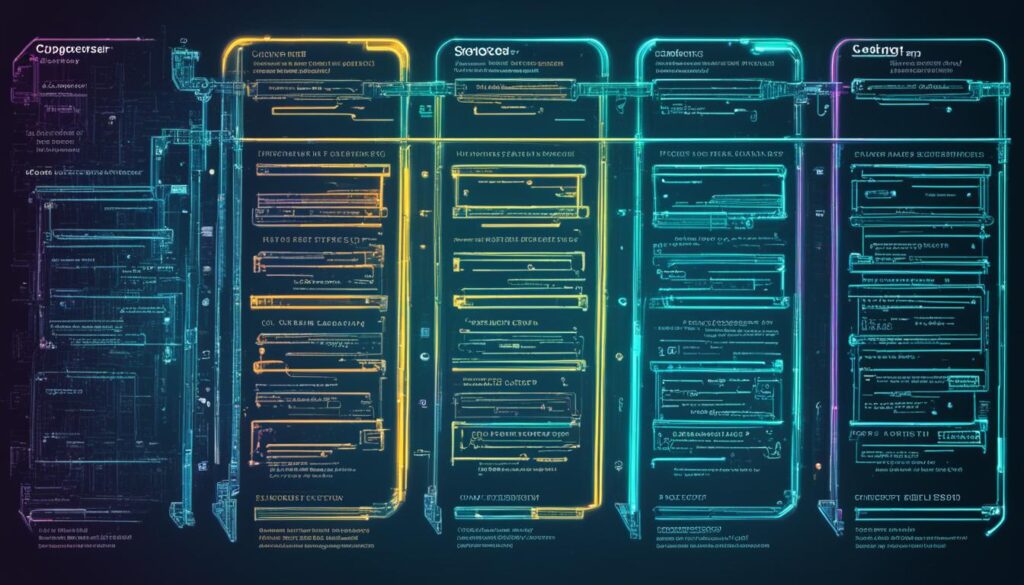Did you know that 90% of security incidents result from exploits against defects in software? In the sprawling landscape of software development, this statistic casts an illuminating light on the importance of secure software deployment. Among the innovative prophylactics for such digital dangers, one practice stands out for its acute relevance: the integration of code signing within Continuous Integration and Continuous Deployment (CI/CD) pipelines. Today, as companies strive for lightning-fast releases without sacrificing quality, DevOps code signing practices provide a formidable shield, ensuring that each piece of code is a trusted link in the chain of software delivery.
Code signing embeds digital signatures onto the software, serving as a virtual seal of authenticity and integrity. With robust DevOps code-signing practices in play, stakeholders enjoy peace of mind, confident that the software they deploy–and more importantly, rely on–has not been compromised. Yet, this is not just a security issue; it’s an imperative that meshes seamlessly with agile development approaches, where rapid iteration and multiple daily deployments are the norm. Let’s delve deeper into how secure code signing practices are redefining the stability and security of CI/CD, turning a potential vulnerability into a bulwark of trust.
Key Takeaways
- Code signing safeguards ensure that the software is secure and trustworthy.
- Integrating code signing with CI/CD aligns with agile and DevOps methodologies for rapid deployment.
- Secure software deployment is enhanced with DevOps code signing practices, making code tamper-proof.
- The automation within CI/CD pipelines offers a streamlined process for secure deployments multiple times per day.
- Establishing a secure CI/CD framework is essential for companies aiming for high-quality, fast-paced software releases.
Understanding CI/CD and the Importance of Security
In the fast-paced world of software development, CI/CD pipeline security and agile development methodologies are the cornerstones of a modern development workflow. By implementing these, organizations facilitate frequent and reliable code releases which are critical in maintaining a competitive edge. Let’s delve into the mechanics of CI/CD and explore the pivotal role of security within these processes.

What is Continuous Integration/Continuous Delivery (CI/CD)?
Continuous Integration and Continuous Delivery, commonly abbreviated as CI/CD, form a methodical approach that aligns with agile development methodologies to enhance software release quality and speed. These automated systems efficiently integrate code updates, conduct thorough testing, and expedite code deployment, contributing to more streamlined and effective product iterations.
The Role of Security in Agile Development and Rapid Release Cycles
In the realm of rapid development and release, security is not a feature that can be sidelined or ignored. Secure practices such as code signing are woven into the fabric of CI/CD pipelines, providing assurances that the code is authentic and unaltered. Such measures are crucial for businesses to establish trust in software updates and new releases. Automated code signing is essential to strengthening CI/CD pipeline security, promoting trust, and maintaining development efficiency.
| CI/CD Component | Purpose | Role of Security |
|---|---|---|
| Continuous Integration (CI) | Automate building, testing, and merging to a shared repository. | Ensure code integrities such as keeping the repository secure from unauthorized changes. |
| Continuous Delivery (CD) | Automate testing and releasing code updates. | Secure transfer of code from repository to deployment environments. |
| Continuous Deployment | Automatic pushes of validated code into production. | Automated code signing to verify authenticity before live release. |
Agile development prioritizes adaptability and speed, but without the underpinning of robust security measures such as those provided within CI/CD frameworks, the risks could outweigh the benefits. Automated code signing and rigorous testing are not just features of a secure pipeline; they’re central pillars upholding the process integrity from start to finish.
Establishing Digital Trust with Code Signing
As the digital landscape evolves, secure code signing processes become imperative for maintaining digital trust in software. This section dives deep into why identities play a critical role in security and the challenges faced by organizations in implementing robust code signing strategies.

The Significance of Identities and Code Signing in Security
Code signing acts as a digital seal, assuring that software comes from a known, trusted source. It is also a testament to the untampered state of the software, fostering a sense of digital trust among users. As the first line of defense against counterfeited or compromised software, it does more than just validate authenticity; it builds confidence in digital interactions and transactions.
Challenges in Secure Digital Trust and Code Signing Implementations
Incorporating secure code signing within various DevOps environments can be a complex endeavor. With the transition to remote and distributed models of work, managing the identities that are linked to code signing requires heightened vigilance to prevent security breaches. The zero-trust security model, which assumes no implicit trust and verifies every attempt at access or communication, underscores the necessity for consistency in code signing processes across all types of deployable assets.
| Asset | Identity Requirement | Security Implications |
|---|---|---|
| Infrastructure Code | Requires unique, verifiable identity | Prevents unauthorized changes to critical systems |
| Container Images | Identity ensures image legitimacy | Enhances trust in containerized applications |
| Applications | Mandatory digital signature for public distribution | Protects end-users from malware and tampering |
| Macros and Scripts | Signatures alleviate concerns of embedded threats | Enables safe incorporation into larger codebases |
Navigating these challenges requires not only advanced technological solutions but also a shift in organizational mindset towards prioritizing the secure execution of digital trust frameworks. By fostering a culture of security, organizations can mitigate risks and ensure that their code signing processes remain an unbreachable bastion of digital trust.
Integrating Code Signing into CI/CD Pipelines
The necessity for continuous integration code signing within CI/CD pipelines is a fundamental aspect of modern software development, where the ease of automating code signing tasks becomes a significant driver for operational efficiency. By following code signing best practices, development teams ensure the security and integrity of their software artifacts throughout the software development lifecycle.

Seamlessly introducing these practices into CI/CD workflows not only fortifies the security of the code but also underscores the importance of maintaining stringent controls in line with corporate security policies. Here’s an overview of the key elements to consider when integrating secure code signing into your CI/CD pipelines:
- Automate signing to match the speed of CI/CD: Implement automation tools that integrate with existing CI/CD tools to reduce the manual work required for code signing.
- Protect private keys: Utilize secure storage solutions for cryptographic keys to prevent unauthorized access and potential breaches.
- Compliance and audit trails: Ensure your code signing process complies with industry regulations, and maintain logs for audit trails and accountability.
- Enforce role-based access: Define and enforce roles and responsibilities for who can sign code, when, and under what circumstances.
To better illustrate the importance of these best practices, consider the following table highlighting key aspects of implementing secure code signing processes within CI/CD pipelines:
| Aspect | Purpose | Benefit |
|---|---|---|
| Automated Signing | Ease the workload of developers by automating the signing of code once it passes the build stage. | Consistency and efficiency in the signing process. |
| Key Security | Protect against unauthorized use of code signing keys to uphold code integrity. | Enhanced security and reduced risk of code tampering. |
| Auditability | Provide mechanisms to track when and how code is signed. | Transparency in the process and adherence to compliance standards. |
| Role-Based Access | Control access to signing capabilities based on user roles. | Clear segregation of duties and minimized insider threat. |
By integrating these elements into your CI/CD pipelines, you advance towards establishing a more secure, efficient, and compliant software development process. The implementation of continuous integration code signing fortifies the trust in software releases, assuring stakeholders that the code has not been compromised from development to deployment.
Automated Code Signing: Enhancing the CI/CD Workflow
The integration of automated code signing stands as a linchpin in fortifying Continuous Integration/Continuous Delivery (CI/CD) pipelines. It introduces a layer of assurance that every piece of code is authenticated and verified, reducing vulnerabilities and ensuring software reliability. Companies like DigiCert® are at the forefront of simplifying this process with powerful management tools designed to incorporate code signing automation seamlessly into the development workflow.

Benefits of Using Automated Code Signing Solutions
Embracing automated code signing solutions, developers can sidestep the labor-intensive and prone-to-error manual processes once associated with code signing. Not only does this accelerate software release cycles, but it also brings about greater security and trust in the end product. Here are some pivotal benefits:
- Boosted security by minimizing the risk of human error in the signing process
- Enhanced efficiency with an automated workflow allowing for more time spent on development
- Consistency in code signing across various stages of software delivery
- Transparency and accountability through logs and reports of when and by whom the code was signed
- Higher trust in software releases thanks to verified digital signatures
Streamlining Development with Integration Tools
Through the integration of robust automation tools, developers can enjoy a more streamlined and focused development experience. Code signing automation tools are designed to fit naturally into the existing CI/CD ecosystems, ensuring that best practices in security can be followed without disrupting the creative flow of software creation.
| Feature | Benefit | Outcome |
|---|---|---|
| Centralized certificate management | Establishes a single source of trust for code signing certificates | Enhanced governance and control over code integrity |
| Automated certificate issuance | Reduces waiting times and manual overhead | Speedier deployment cycles and reduced bottlenecks |
| Compliance with security policies | Ensures adherence to corporate and regulatory standards | Increased software trust and reduced legal risks |
| Integration with existing CI/CD tools | Maintains developer environments and workflows | Improved adoption rates and less disruption to productivity |
By effectively harnessing automated code signing and associated integration tools, organizations can significantly bolster the security and efficiency of their software delivery pipelines. This evolution in the development process secures a higher caliber of software products that businesses—and their customers—can depend on.
Best Practices for Secure Code Signing Processes
Ensuring the security and integrity of software through secure code signing processes is vital in the modern digital landscape. As threats escalate and compliance demands tighten, organizations must establish robust code signing practices to safeguard their products and reputation.
Implementing a Code Signing Maturity Model
Adopting a code signing maturity model offers organizations a framework to assess and enhance their code signing protocols. This structured approach can be instrumental in identifying weaknesses and pinpointing areas of improvement as you scale from basic to advanced secure code signing processes.

Centralized Management of Signing Keys
Centralizing the management of signing keys is a cornerstone of maturing code signing practices. It eliminates scattered key storage and inconsistent signing procedures, significantly reducing potential security breaches and ensuring only authorized personnel access sensitive signing capabilities.
| Maturity Level | Characteristics | Recommended Actions |
|---|---|---|
| Level 0 | No formal code signing practices | Establish a basic code signing protocol |
| Level 1 | Manual, ad-hoc code signing | Begin central management of keys |
| Level 2 | Automated signing with minimal audit controls | Introduce auditability and key protection measures |
| Level 3 | Automated, auditable signing with enforced policies | Integrate signing with CI/CD pipeline |
| Level 4 | Full governance with code signing policy enforcement | Employ hardware security modules for key protection |
Progressing through each level of the code signing maturity model aligns organizations with industry best practices and strengthens their defences against unapproved code changes, malware insertion, and other security risks. Committing to these practices is central to maintaining trust in an organization’s software offerings.
Code Signing Integration Tools and Their Impact
As the digital landscape evolves, so does the necessity for robust security solutions. In this effort, code signing integration tools have emerged as a cornerstone for ensuring the authenticity and integrity of software releases during the development lifecycle. Central to these advancements is Keyfactor Signum, a leader in cloud-based code signing innovation, offering secure and efficient management of software signing processes.
Integrating Keyfactor Signum for Secure Code Signing
Keyfactor Signum is at the forefront of integrating secure code signing practices into DevOps workflows. Providing features like key protection within Hardware Security Modules (HSMs), detailed audit logs, and strict enforcement of access policies, Signum tackles significant security challenges that developers and administrators face daily. Keyfactor’s seamless fit into CI/CD pipelines allows for streamlined code signing without disrupting existing procedures—the essence of effective security integration.
Advantages of Cloud-Based Signing Tools for DevOps
With a shift toward cloud-based solutions, the adoption of cloud-based signing tools like Keyfactor Signum offers numerous advantages to DevOps practices. Such tools simplify the signing process by granting remote access to secure signing capabilities, an indispensable feature in today’s distributed work environments. Furthermore, cloud-based solutions grant administrators precise control over who can sign code and when, thereby enhancing overall governance and security compliance within the CI/CD pipeline.
Ultimately, the integration of code signing tools not only bolsters security but also facilitates better resource management and operational efficiency. As organizations continue to navigate the complexities of software development and deployment, the role of integrative technologies like Keyfactor Signum becomes all the more vital for a sustainable and secure DevOps culture.
Continuous Integration Code Signing for DevSecOps
Trust and security are the cornerstones of modern software development, vital in the era of rapid deployment and complex digital ecosystems. Continuous integration code signing plays a pivotal role in establishing this trust, embedding indispensable security practices into the agile development lifecycle. By automating this process, organizations pursuing a DevSecOps model can significantly mitigate risks while maintaining the pace of continuous innovation.
Building Trust Through Every Stage of Software Development
In the continuous effort to achieve both speed and security, code signing serves as an essential validation measure. Automated signing processes verify that every change introduced to the codebase is authorized and secure. As developers commit code, these verifications ensure that every stage, from initial development to final deployment, maintains an unbroken chain of trust. This guarantee does not only facilitate compliance with security standards but also nurtures confidence among stakeholders and customers in the software’s reliability.
Embedding Security into the CI/CD Pipeline with Code Signing
Integrating code signing within the CI/CD pipeline fortifies the DevSecOps approach, embedding a strong security posture seamlessly within the development workflow. This integration molds security into the very fabric of the software delivery process, ensuring that each artifact produced—be it a binary, script, or configuration file—is authenticated and untampered, thereby reinforcing the overall security framework.
An automated code signing strategy within CI/CD pipelines accomplishes the following goals:
- It maintains the integrity of the code at every iteration.
- It prevents the progress of unsigned or altered artifacts through the deployment stages.
- It enables trusted artifact traceability, from development to production.
- It streamlines the security checks without introducing bottlenecks.
Developers, security teams, and operations managers alike benefit from the robustness of a DevSecOps environment where continuous integration code signing is a standard practice. By making security an inseparable part of the development process, organizations can aspire to achieve the coveted balance between swift market delivery and uncompromising software security.
Preventing Software Supply Chain Attacks with Secure Signing
In the landscape of digital security, secure software deployment has never been more critical. The surge in software supply chain attacks has emphatically demonstrated the importance of protective measures in the development and distribution process. In response, industry leaders have revamped their deployment strategies, adopting a rigorously proactive stance to counter these evolving threats.
Lessons from Recent Cyberattacks on Development Pipelines
The infiltration of software systems via supply chain assaults, leading to disastrous breaches in cases like SolarWinds and Kaseya, serves as a stark reminder. These episodes highlight the exploits found within seemingly secure arenas and underscore the critical need for a fortified defense mechanism that pervades every stage of the software lifecycle.
The ‘Sign Early, Sign Often’ Approach to Secure Deployment
Embracing the mandate of ‘sign early, sign often,’ developers are now prioritizing the integration of security signatures early in the development cycle, ensuring each component is verified prior to progression to the next stage. Ensuring that each transitional artifact is duly signed and validated is paramount to preventing unauthorized interference and sabotage.
Secure signing principles have been adeptly woven into the fabric of platforms like GitLab, streamlining the process for developers to employ digital signatures without the need to dive deeply into the complexities of Public Key Infrastructure (PKI). This seamless integration reinforces the defences against software supply chain attacks, fortifying the secure software deployment pipeline against unauthorized intrusions.
Conclusion
As we anticipate the future of secure CI/CD, the role of integrated code signing cannot be overstated. This fundamental practice is fast becoming the backbone of software security in the fluid and dynamic sphere of DevOps. With the digital landscape evolving and threat vectors multiplying, the integration of robust code signing protocols is no longer optional but a cornerstone for maintaining the integrity of software delivery processes.
The Future of Secure CI/CD with Code Signing Integration
Looking ahead, the future of secure CI/CD will hinge on our ability to weave code signing practices seamlessly into every facet of software development and deployment. Organizations are bound to prioritize advancements that bolster their security posture, with a focus on enhancing the resilience and reliability of their CI/CD pipelines. In this regard, the effective management and automation of code signing will emerge as critical components, ensuring that every piece of code is authenticated and safeguarded against tampering.
Adopting Comprehensive Security Measures for Integrity in DevOps
Commitment to comprehensive security measures in DevOps is set to define the new standard for secure software operations. By consolidating efforts between security professionals and DevOps teams and leveraging innovative cloud-based solutions like Keyfactor Signum, organizations are poised to cultivate a robust defense against nefarious activities. Secure code signing practices, embedded deep within the CI/CD workflow, will be instrumental in fortifying the trustworthiness of the entire software supply chain—truly an indispensable measure for safe, reliable code deployment in an increasingly interconnected world.
FAQ
What is Continuous Integration/Continuous Delivery (CI/CD)?
Continuous Integration (CI) is a practice in software development where developers frequently merge their code changes into a central repository, after which automated builds and tests are run. Continuous Delivery (CD) extends CI by ensuring that code changes can be automatically tested and are ready for a release to production.
The Role of Security in Agile Development and Rapid Release Cycles?
In agile development, the rapid release of software requires robust security measures to ensure that the code is safe from vulnerabilities and unauthorized alterations. Security practices like automated code signing are integrated into the CI/CD pipelines to maintain the integrity and trust of software releases.
The Significance of Identities and Code Signing in Security?
Code signing is crucial in establishing digital trust as it proves the authenticity of software by verifying the identity of the code publisher and ensuring that the code has not been tampered with since signing. It is essential for confirming the security and integrity of software in digital ecosystems.
Challenges in Secure Digital Trust and Code Signing Implementations?
A significant challenge is managing and protecting the identities that are intrinsic to code signing, especially with the prevalence of remote work and complex toolchains. Safeguarding signing keys and certificates against misuse or compromises while allowing developer freedom requires a balance of control and accessibility within DevOps practices.
Benefits of Using Automated Code Signing Solutions?
Automated code signing solutions streamline the software deployment process, reduce the risk of human error, and ensure that the code signing practices are consistent across the development lifecycle. Solutions like DigiCert® Software Trust Manager can automatically enforce code signing, thereby improving security and compliance.
Streamlining Development with Integration Tools?
Integration tools, such as Keyfactor Signum, allow organizations to incorporate code signing directly into their CI/CD processes, making it easier for developers to follow security protocols without disrupting their workflows. This helps in maintaining a secure software development environment without sacrificing speed and efficiency.
Implementing a Code Signing Maturity Model?
Organizations should adopt a code signing maturity model to advance their security posture. This involves moving from ad hoc and manual code signing processes towards more structured, automated, and auditable practices. Using HSMs and integrating code signing into CI/CD are steps towards achieving higher maturity levels.
Centralized Management of Signing Keys?
Centralizing key management helps in ensuring that private keys are secure and access to them is controlled. This reduces the likelihood of key compromise and supports governance, compliance, and auditability within the code signing process.
Integrating Keyfactor Signum for Secure Code Signing?
Keyfactor Signum is a solution that allows for secure code signing certificate management, offering features like HSM integration, audit trails, and automated policy enforcement. It is designed to overcome common challenges related to key storage and access control.
Advantages of Cloud-Based Signing Tools for DevOps?
Cloud-based signing tools provide flexibility and ease of use for teams working across various locations. They support secure signing of code with tools that are accessible online, integrating easily into the developers’ current workflows and enhancing overall security posture in DevOps environments.
Building Trust Through Every Stage of Software Development?
Integrating code signing into each stage of the software development process ensures that every component, from code to executables, is authentic and unmodified. This builds a foundation of trust and security throughout the development lifecycle.
Embedding Security into the CI/CD Pipeline with Code Signing?
Embedding code signing into the CI/CD pipeline is a practice that reinforces the security of the DevSecOps environment. It allows teams to enforce policies where only signed and verified code can progress through the stages of development, testing, and deployment.
Lessons from Recent Cyberattacks on Development Pipelines?
Cyberattacks like those on SolarWinds and Kaseya highlight the necessity for enhanced security measures, particularly in the CI/CD pipeline. These lessons teach us the importance of signing code early and regularly to prevent unauthorized changes and software supply chain attacks.
The ‘Sign Early, Sign Often’ Approach to Secure Deployment?
The ‘Sign Early, Sign Often’ approach advises that code and its associated artifacts should be signed at every possible step in the development process. This ensures ongoing validation of integrity and origin, establishing a strong deterrent against tampering and adding a protective layer to the supply chain.
The Future of Secure CI/CD with Code Signing Integration?
The future of secure CI/CD involves a tighter integration of code signing processes into development workflows. This will become increasingly crucial for ensuring software integrity in DevOps, with a focus on centralized management, automation, and compatibility with existing development tools and practices.
Adopting Comprehensive Security Measures for Integrity in DevOps?
To maintain integrity within DevOps, organizations need to adopt comprehensive security measures. This includes the use of automated code signing, centralized key management, and adopting cloud-based solutions to secure the software delivery process at every stage of the pipeline.





